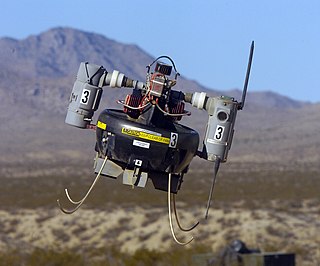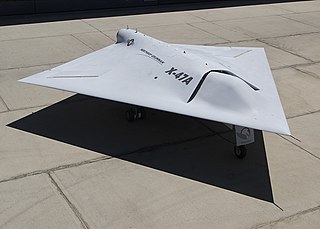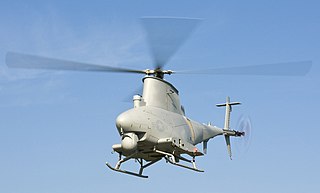
The Defense Advanced Research Projects Agency (DARPA) is a research and development agency of the United States Department of Defense responsible for the development of emerging technologies for use by the military. Originally known as the Advanced Research Projects Agency (ARPA), the agency was created on February 7, 1958, by President Dwight D. Eisenhower in response to the Soviet launching of Sputnik 1 in 1957. By collaborating with academia, industry, and government partners, DARPA formulates and executes research and development projects to expand the frontiers of technology and science, often beyond immediate U.S. military requirements. The name of the organization first changed from its founding name, ARPA, to DARPA, in March 1972, changing back to ARPA in February 1993, then reverted to DARPA in March 1996.

A micro air vehicle (MAV), or micro aerial vehicle, is a class of man-portable miniature UAVs whose size enables them to be used in low-altitude, close-in support operations. Modern MAVs can be as small as 5 centimeters - compare Nano Air Vehicle. Development is driven by commercial, research, government, and military organizations; with insect-sized aircraft reportedly expected in the future. The small craft allow remote observation of hazardous environments or of areas inaccessible to ground vehicles. Hobbyists have designed MAVs for applications such as aerial robotics contests and aerial photography. MAVs can offer autonomous modes of flight.

The Boeing X-45 unmanned combat air vehicle is a concept demonstrator for a "next generation" of completely autonomous military aircraft, developed by Boeing's Phantom Works. Manufactured by Boeing Integrated Defense Systems, the X-45 was a part of DARPA's J-UCAS project.

The Northrop Grumman X-47 is a demonstration unmanned combat aerial vehicle. The X-47 began as part of DARPA's J-UCAS program, and is now part of the United States Navy's UCAS-D program to create a carrier-based unmanned aircraft. Unlike the Boeing X-45, initial Pegasus development was company-funded. The original vehicle carries the designation X-47A Pegasus, while the follow-on naval version is designated X-47B.

Joint Unmanned Combat Air Systems, or J-UCAS, was the name for the joint U.S. Navy and U.S. Air Force unmanned combat air vehicle procurement project. Originally two separate projects of the U.S. Air Force and Navy respectively: UCAV and UCAV-N; both programs merged in 2003. The two vehicles involved in J-UCAS were the Boeing X-45 and Northrop Grumman X-47A Pegasus, originally part of UCAV and UCAV-N respectively. J-UCAS was managed by the Defense Advanced Research Projects Agency. In the 2006 Quadrennial Defense Review, it was stated that the J-UCAS program would be terminated and instead a new long-range strategic bomber program, Next-Generation Bomber, for the Air Force would launch. The program was revitalized into a Navy-only program named UCAS-D.

AeroVironment, Inc. is an American defense contractor headquartered in Arlington, Virginia, that designs and manufactures unmanned aerial vehicles (UAVs). Paul B. MacCready Jr., a designer of human-powered aircraft, founded the company in 1971. The company is best known for its lightweight human-powered and solar-powered vehicles. The company is the US military's top supplier of small drones —notably the Raven, Switchblade, Wasp and Puma models.

Boeing Phantom Works is the advanced prototyping arm of the defense and security side of Boeing. Its primary focus is developing advanced military products and technologies, many of them highly classified.

A miniature UAV, small UAV (SUAV), or drone is an unmanned aerial vehicle small enough to be man-portable. Smallest UAVs are called micro air vehicle.

Robert C. Michelson is an American engineer and academic who invented the entomopter, a biologically inspired flapping-winged aerial robot, and who established the International Aerial Robotics Competition. Michelson's career began at the U.S. Naval Research Laboratory. He later became a member of the research faculty at the Georgia Institute of Technology. He is the author of three U.S. patents and over 100 journal papers, book chapters and reports. Michelson is the recipient of the 1998 AUVSI Pioneer Award and the 2001 Pirelli Award for the diffusion of scientific culture as well as the first Top Pirelli Prize.

The Northrop Grumman MQ-8 Fire Scout is an unmanned autonomous helicopter developed by Northrop Grumman for use by the United States Armed Forces. The Fire Scout is designed to provide reconnaissance, situational awareness, aerial fire support and precision targeting support for ground, air and sea forces. The initial RQ-8A version was based on the Schweizer 330, while the enhanced MQ-8B was derived from the Schweizer 333. The larger MQ-8C Fire Scout variant is based on the Bell 407.

The Boeing A160 Hummingbird is an unmanned aerial vehicle (UAV) helicopter. Its design incorporates many new technologies never before used in helicopters, allowing for greater endurance and altitude than any helicopter currently in operation.

The EADS Barracuda was a jet powered unmanned aerial vehicle (UAV), EADS, used for the role of aerial reconnaissance and also combat. The aircraft was a joint venture between Germany and Spain.
Karem Aircraft, Inc. is an American aerospace manufacturer company with offices in Lake Forest, California; York, Virginia; and Victorville, California, founded in 2004 by Abraham Karem as a rapid development firm specializing in advanced tiltrotor transport aircraft. Karem was the former chief designer for the Israeli Air Force — who built his first drone during 1973's Yom Kippur War — and has been described by The Economist as the man who "created the robotic plane that transformed the way modern warfare is waged — and continues to pioneer other airborne innovations". He emigrated to the United States in the late 1970s.

The Boeing AH-6 is a series of light helicopter gunships based on the MH-6 Little Bird and MD 500 family. Developed by Boeing Rotorcraft Systems, these include the Unmanned Little Bird (ULB) demonstrator, the A/MH-6X Mission Enhanced Little Bird (MELB), and the proposed AH-6I and AH-6S.

Airborne ground surveillance (AGS) refers to a class of military airborne radar system used for detecting and tracking ground targets, such as vehicles and slow moving helicopters, as opposed to Airborne early warning and control, whose primary role is detecting and tracking aircraft in flight. Antenna beam width should be very small to enhance resolution. This antenna size limitation demands high frequency of operation, to be operated in this mode. AGS radar is typically a medium or low power radar. It includes both maritime and land surveillance. Today, UAVs perform this operation, which often uses optical aids for surveillance.

Aurora Flight Sciences (AFS) is an American aviation and aeronautics research subsidiary of Boeing that specializes in special-purpose unmanned aerial vehicles. Aurora's headquarters is at Manassas Regional Airport.

Ghatak (pronounced: gʰɑːt̪ək; lit. 'Deadly' in Sanskrit), initially designated as Indian Unmanned Strike Air Vehicle (IUSAV), is an autonomous jet powered stealthy unmanned combat aerial vehicle (UCAV), being developed by Aeronautical Development Establishment (ADE) of the Defence Research and Development Organisation (DRDO) for the Indian Air Force. The design work on the UCAV is to be carried out by Aeronautical Development Agency (ADA). Autonomous Unmanned Research Aircraft (AURA) was a tentative name for the UCAV. Details of the project are classified.
AdamWorks, LLC (AdamWorks), is an American engineering and manufacturing organization specializing in designing, tooling and manufacturing of composite structures and mechanical systems.

The Tactical Robotics Cormorant, formerly AirMule or Mule, Israel Defense Forces (IDF) codename Pereira, is a flying car unmanned aerial vehicle (UAV) built by Tactical Robotics Ltd., a subsidiary of designer Rafi Yoeli's Urban Aeronautics Ltd., in Yavne, Israel. It will be used in search and rescue operations where it is too dangerous or inaccessible for a helicopter, such as evacuating people from the upper stories of burning buildings, or delivering and extracting police and soldiers while very close to structures, narrow streets, or through holes into confined spaces.
















